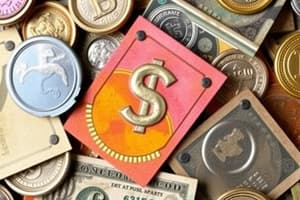Podcast
Questions and Answers
Which of the following is NOT a function of money?
Which of the following is NOT a function of money?
- Unit of account
- Medium of exchange
- Store of value
- Unit of production (correct)
Fiat money derives its value from its inherent worth, such as gold or silver.
Fiat money derives its value from its inherent worth, such as gold or silver.
False (B)
What is the term for the ease with which an asset can be converted into cash?
What is the term for the ease with which an asset can be converted into cash?
Liquidity
The ______ rate is the interest rate at which banks can borrow money from the central bank.
The ______ rate is the interest rate at which banks can borrow money from the central bank.
Which of the following is NOT a tool used by central banks to control the money supply?
Which of the following is NOT a tool used by central banks to control the money supply?
Credit refers to the ability to borrow money.
Credit refers to the ability to borrow money.
Match the following money supply tools with their descriptions:
Match the following money supply tools with their descriptions:
Deposits made by individuals in a bank are considered loans to the bank.
Deposits made by individuals in a bank are considered loans to the bank.
What is the primary reason banks are required to maintain a fraction of deposits in reserve?
What is the primary reason banks are required to maintain a fraction of deposits in reserve?
What is the relationship between deposits and the money supply?
What is the relationship between deposits and the money supply?
Inflation refers to a sustained ______ in the general price level of goods and services in an economy.
Inflation refers to a sustained ______ in the general price level of goods and services in an economy.
Which of the following is NOT a cause of inflation?
Which of the following is NOT a cause of inflation?
Match the following inflation types with their description.
Match the following inflation types with their description.
Deflation is a sustained decrease in the general price level of goods and services, and it can benefit the economy.
Deflation is a sustained decrease in the general price level of goods and services, and it can benefit the economy.
What is the primary role of interest rates in the economy?
What is the primary role of interest rates in the economy?
Central banks often use ______ as a tool to manage the money supply and inflation.
Central banks often use ______ as a tool to manage the money supply and inflation.
Which of the following is NOT a factor that influences interest rates?
Which of the following is NOT a factor that influences interest rates?
Flashcards
Deposits as loans
Deposits as loans
Deposits in a bank are loans given by depositors to the bank.
Fractional reserve banking
Fractional reserve banking
Banks keep only a fraction of deposits in reserve, lending out the rest.
Money supply
Money supply
The total amount of money available in an economy.
Inflation
Inflation
Signup and view all the flashcards
Demand-pull inflation
Demand-pull inflation
Signup and view all the flashcards
Cost-push inflation
Cost-push inflation
Signup and view all the flashcards
Managing inflation
Managing inflation
Signup and view all the flashcards
Deflation
Deflation
Signup and view all the flashcards
Effects of deflation
Effects of deflation
Signup and view all the flashcards
Interest rates
Interest rates
Signup and view all the flashcards
Functions of Money
Functions of Money
Signup and view all the flashcards
Medium of Exchange
Medium of Exchange
Signup and view all the flashcards
Unit of Account
Unit of Account
Signup and view all the flashcards
Store of Value
Store of Value
Signup and view all the flashcards
Supply of Money
Supply of Money
Signup and view all the flashcards
Monetary Policy
Monetary Policy
Signup and view all the flashcards
Demand for Money
Demand for Money
Signup and view all the flashcards
Credit
Credit
Signup and view all the flashcards
Role of Banks
Role of Banks
Signup and view all the flashcards
Money Creation
Money Creation
Signup and view all the flashcards
Study Notes
Introduction to Money
- Money acts as a medium of exchange, a store of value, and a unit of account.
- It streamlines transactions and enables efficient resource allocation.
- Money facilitates trade and specialization.
- Types of money include commodity money (e.g., gold, silver) and fiat money (e.g., paper currency), which derives its value from government decree.
Functions of Money
- Medium of Exchange: Facilitates transactions without direct bartering, solving the "double coincidence of wants" problem.
- Unit of Account: Provides a common value measure for goods and services, streamlining pricing and budgeting.
- Store of Value: Allows saving purchasing power over time, though its value can fluctuate with inflation or deflation.
Supply of Money
- Money supply represents the total amount of money in an economy at a given time.
- Central banks control the money supply via:
- Monetary Policy: Actions influencing interest rates and credit availability.
- Reserve Requirements: Percentage of deposits banks must hold.
- Discount Rate: Interest rate for banks borrowing from the central bank.
- Open Market Operations: Buying and selling government securities.
- Monetary Policy: Actions influencing interest rates and credit availability.
Demand for Money
- Transactions Demand: Holding money for everyday purchases. Liquidity is the ease of converting an asset to cash.
- Precautionary Demand: Holding money for unforeseen expenses.
- Speculative Demand: Holding money in anticipation of interest rate changes.
Credit
- Credit enables borrowing money.
- Loans provide funding for individuals and businesses.
- Banks function as crucial intermediaries in the credit market, connecting borrowers and lenders.
Role of Banks
- Banks accept deposits and offer loans.
- Banks create money through lending a significant portion of deposited funds.
- Banks are essential components of the payments system.
Importance of Financial Institutions
- Financial institutions transfer funds from savers to borrowers.
- Examples include commercial banks, credit unions, and savings and loan associations.
- These institutions manage risks and facilitate investments.
Money Creation
- Banks generate money through lending.
- Initially, a deposit creates new money, as deposits are essentially loans to banks. The new money enters the money supply.
- Fractional reserve banking: Banks hold a portion of deposits as reserves.
Inflation
- Inflation is a sustained rise in the general price level of goods and services.
- Causes include demand-pull inflation (excessive demand) and cost-push inflation (rising production costs).
- Managing inflation is a central banking priority.
Deflation
- Deflation is a sustained fall in the general price level.
- Deflation can discourage spending and investment, harming the economy.
Interest Rates
- Interest rates indicate the cost of borrowing money.
- Interest rates influence borrowing and lending decisions.
- Central banks use interest rates to manage money supply and inflation.
Studying That Suits You
Use AI to generate personalized quizzes and flashcards to suit your learning preferences.




